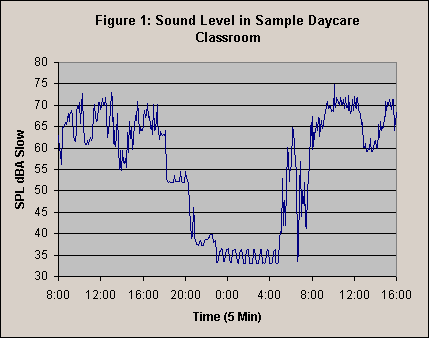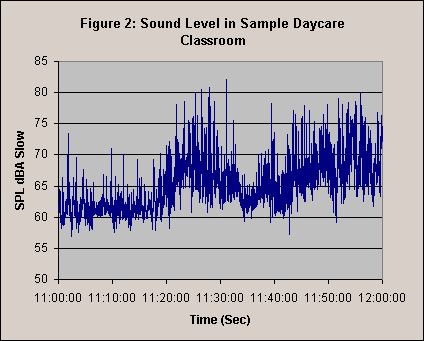Matthew V. Golden mvg103@psu.edu
Penn State Graduate Program in Acoustics
P.O. Box 30 State College, PA 16804
Tom Frank
5-A Moore Building
University Park, PA 16802
Popular version of paper 3aAA6
Presented Thursday morning, June 1, 2000
139th ASA Meeting, Atlanta, GA
Recently there has been several articles published showing that the learning success rate of
children taught in classrooms having good acoustics is significantly higher than those taught in
classrooms having poor acoustics. Most of the research concerning classroom acoustics has been
conducted in elementary, secondary, and college classrooms while very little research has been
conducted in daycare classrooms. This is unfortunate since a very significant amount of learning
takes place in the early years of a child's life, especially for developing speech and language
skills. Further, children spend more time in daycare classrooms than their parents spend
working. Thus, if young children are attending daycare classrooms having very poor acoustical
conditions their learning and speech and language skills may suffer. Because of this and some
other factors, research is being done to determine the acoustical conditions of daycare
classrooms attended by infants and toddlers. 
The acoustical conditions of a classroom can be characterized by determining the overall noise level, the reverberation time (i.e., the time it takes for sound to fade away), and the signal to noise ratio (SNR). The SNR is the decibel difference between the level of a signal and the level of the background noise. Typically, the signal is the level of the teacher's voice and the background noise is the noise generated by the children in the classroom and other noises, which may include the heating and air conditioning system and traffic noise. An ideal classroom would have very low background noise levels and a low reverberation times and high SNRs.
Although there are several ways to measure the background noise, perhaps the best way to fully
characterized and determine background noise levels is to measure the noise over a long period.
This was done using a microphone and a computer based data acquisition system that recorded the
noise levels in several daycare classrooms once every second for two days. Figure 1
shows a
typical recording of the sound levels in a daycare classroom were the noise levels were averaged
over five minute blocks. These, noise levels can be correlated with the various activities in
the classrooms. These activities can include play time, book reading, lunch, naptime, etc.
More importantly, Figure 1 shows that the noise level in a daycare classroom is never constant.
For example, the noise level is greater then 65dB when the children were playing or getting
ready to eat and was lower when the children were either napping or were outside. When the
noise levels are examined over a period of an hour in one-second intervals, as shown Figure 2,
it is easy to see that the noise in a daycare classroom is very dynamic; that is, the noise is
constantly changing over time.
This occurs because all the children are noise sources, which
is different from a traditional classroom where the teacher is usually the only person speaking
and the children are all quietly listening. Do to the dynamic nature of the noise in daycare
classrooms, it is difficult to determine an average noise level as typically done for traditional
classrooms.
Reverberation time is another important quantity to measure in order characterize the acoustical conditions in a classroom. Since daycare classrooms typically have more sound absorbing materials in and around the room then traditional classrooms the reverberation time is lower. Thus, speech will be easier to understand since sounds in a word will not blend together.
The most important variable characterizing the acoustical conditions in a classroom is the SNR. Ideally, the SNR should be greater than 15dB, for maximum understanding. Which would mean that the speech level would be greater than 15dB louder then the noise. It is customary to estimate the SNR in classrooms by comparing previously published speech levels to the classroom background noise levels. When this has been done, the estimated SNRs were -5dB to 10dB depending on the vocal effort of the speaker. If these estimates are correct, a female teacher in a daycare classroom would have to constantly speak with a raised voice to be understood. In order to obtain a more realistic measurement of SNRs in a daycare classroom, data is currently being collected. This is being done by having children wear a wireless microphone to record the level of teachers voice and the level of the background noise when the teacher is not speaking during several daycare activities. The information obtained will provide insight as to the dynamic SNR changes that occur in daycare classrooms.
Once all of the data concerning the overall background noise levels, reverberation times, and SNRs has been analyzed, we will be able to determine if the acoustical conditions in daycare classrooms are conducive to learning. Further, we will be able to determine if the acoustical conditions in classrooms are similar to those found in traditional occupied by older children. To date, we have found that the background noise levels in twenty-eight daycare classrooms is similar to the noise levels found in traditional classrooms occupied by older children. The reverberation times in fourteen daycare classrooms were less than the reverberation times found in traditional classrooms.